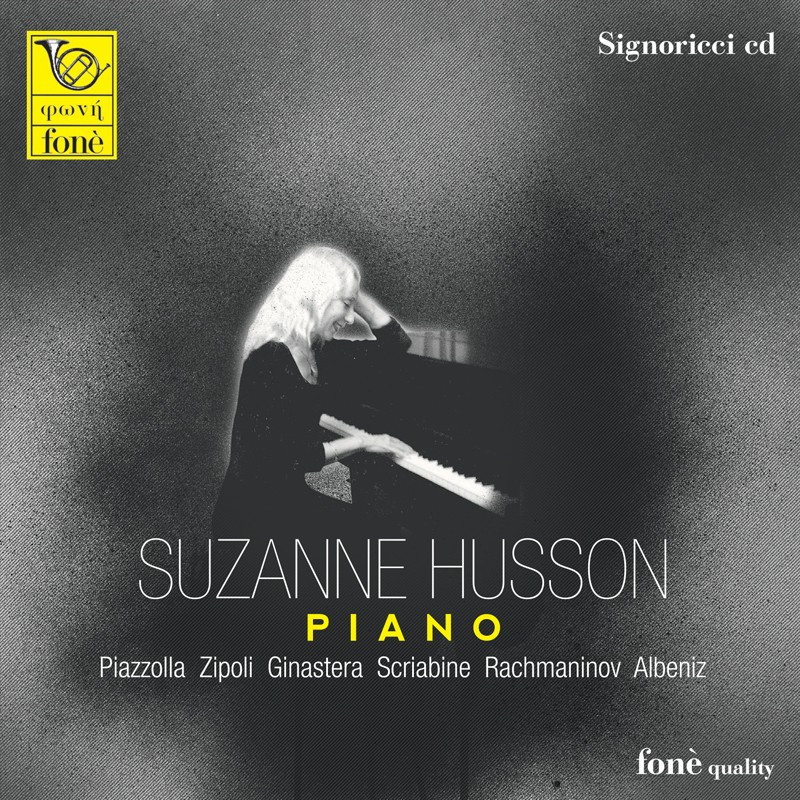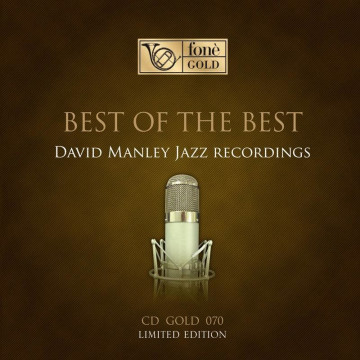Suzanne Husson - Piano

Suzanne Husson PIANO (cd)
Astor Piazzolla 1921 - 1992
3 Preludi
1. Leijia's game Tango 2'44''
2. Flora's game Milonga 5'55''
3. Sunny's game Valzer 3'37''
Domenico Zipoli 1688 -1726 Alberto Ginastera 1916 - 1983
4. Toccata 6'20''
Alberto Ginastera 1916 - 1983
Sonata n. 1 Op. 22
5. Allegro marcato 4'11''
6. Presto misterioso 2'20''
7. Adagio molto appassionato 4'25''
8. Ruvido ed ostinato 2'58''
Alexander Scriabin 1872 - 1915
9. Notturno per la mano sinistra Op. 9 N°2 5'00''
3 Studi
10. N°10 Op. 8 2'00''
11. N°12 Op. 8 2'27''
12. N°5 Op. 42 3'38''
Sergej Rachmaninov 1873 - 1943
13. Elegia N°1 Op. 3 4'49''
3 Preludi
14. N°2 Op. 3 3'26''
15. N°6 Op. 23 3'10''
16. N°5 Op. 23 3'51''
Isaac Albeniz 1860 - 1909
17. Granada Suite espagnole N°1 4'47''
Total Time 1h 5'48"
Conceived, recorded and produced by Giulio Cesare Ricci
Recorded at Teatro Persio Flacco in Volterra (PI)
Recording date November 2010
Recording assistant Paola Liberato
Tube microphones Neumann U47, U48, M49
Mike pre-amplifiers, line, digital, microphone, supply cables Signoricci
Recorded in stereo DSD on the Pyramix Recorder using dCS A/D and D/A converters
A special thanks to Piergiovanni Marchi President of Accademia dei Riuniti – Teatro Persio Flacco for the open welcoming during the period when the recording has been taking place.
Astor Piazzolla (1921-1992)
A productive composer (he wrote over a thousand pieces), Astor Piazzolla is most famous for his revolutionary « tango nuevo », blending traditional tango, folk and classical music with jazz. He was born in Mar del Plata (Argentina) on 11th March 1921. Both his parents were Italian immigrants who moved to New York in search of better opportunities. Of his difficult youth, Piazzolla remembers « … hanging out rather than attending school, listening to jazz at the door of the Cotton Club, I was both too young and too poor to be admitted. My musical world revolved around jazz (from Duke Ellington to Cab Calloway) and my father’s old gramophone recordings of Carlos Gardel’s nostalgic tangos. When I was 9, my father gave me a bandoneon and I had lessons with a teacher who taught classical music. » Aged 16, Piazzolla settled in Buenos Aires and learned piano and harmony with a young professor called … Alberto Ginastera. In the 1950s, Piazzolla met Nadia Boulanger in Paris who advised him not to focus on « scholarly » music but on his own intuitive brand of tango with classical and jazz forms. Thus, in 1955, he first set up an octet, then formed the quintet which became world-famous. Throughout his most successful career, he associated with artists such as Argentinian author Luis Borges, Italian violinist Salvatore Accardo and jazz sax-player Jerry Mulligan. Composed in 1987, the 3 preludes are perhaps his best-known work for piano, presenting three different aspects of tango. The second one, Flora’s game, is a Milonga, a dance from which tango is derived. Both melodious and virtuous, it is technically demanding. The third one, Sunny’s game,
as a tango version of a waltz.
Domenico Zipoli (1688-1726)
On the edition Boosey & Hawkes of this toccata Ginastera inserts the following comments: «Domenico Zipoli dated his Toccata per Organo January lst, 1716 at Rome. Zipoli’s life was a short and agitated one. In July 1716 he entered the noviciate of the Society of Jesus at Seville. On April 5th l717, he left Cadiz for the Rio de la Plata, arriving in Buenos Aires in July of that year.
Lauro Ayestaran relates that Zipoli remained in that city for a fortnight and then left for Cordoba in a slow ox-waggon. On January 2nd, 1726, he died aged 37 at the ranch of the Jesuits at Santa Catalina. Born on October 16th, 1688, at Prato in the Grand Duchy of Tuscany, Zipoli enjoyed the protection of the Grand Duke of Florence. He studied with Alessandro Scarlatti in Naples (from whom he parted as a result of “acute difference”) and shone in the salons of Rome, thanks to his talent and masterly skill. In colonial Cordoba, this musician conferred “a great solemnity on the religious celebrations through his music, to the delight both of the Spaniards and of the neophytes” (P. Pedro Lozano: Cartas Anuas 1720-1730, Staatsarchiv, Munich). One of the greatest organists of all times, Zipoli was the first composer to visit our country and link us both materially and spiritually with Europe. I submit this musical composition to the hands of pianists so that his work may be better known and admired, hoping that their art will enable them to transmit the beauty of his music…… » Alberto Ginastera - Villa Gesell, Argentina, February 2lst, 1970
Alberto Ginastera (1916-1983)
« Alberto Ginastera is one of the great composers of our time…. The fact that he is Argentinian reminds us of that Latin American music now rivals that of North America or Europe thanks to three great figures: Villa-Lobos, Chavez and Ginastera. » (Tomas Marco in his Preface to « Ginastera » by Eduardo Storni) * Born in Buenos Aires, Ginastera graduated from that city’s National Conservatory in 1938. At the age of 18 he composed Panambi, a ballet, performed in the Teatro Colon in 1937. Acclaimed internationally, Ginastera nevertheless dedicated himself to teaching and promoting contemporary music in Argentina. His Sonata n°1, opus 22, commissioned for the 1952 Pittsburgh Festival, was described as « the greatest piano sonata of the decade » by a Berlin critic in 1961. Like the three Danzas argentinas, it evokes the immensity of the Argentinian pampa. More recently, after a splendid recital in Geneva, Daniel Robellaz wrote: « The Sonata n°1, op.22, has kept its fresh and modern tone. Brilliantly written, the movements range from the visionary Allegro marcato, Ruvido e ostinato, to the diabolical Presto Misterioso; the expressionist Adagio molto appassionato recalls Berg or Scriabin. This fascinating piece is perfectly suited to Suzanne Husson’s steel touch and fiery personality. » (Journal de Genève, February 1991)
*Eduardo Storni: Ginastera Ed. ESPASA-CALPE, Madrid 1983 - Musicos de nuestro tiempo.
Alexander Scriabine (1872-1915)
Alexander Scriabine was born in Moscow where he studied and then taught for 7 years. Considered as one of the forerunners of 20th-century music, his first compositions were nevertheless influenced by Chopin and Liszt. Famous pianists, Vladimir Sofronitski, Samuel Feinberg, and Vladimir Horowitz were enthusiastic about his works and contributed to make them known. Scriabin wrote the Nocturne for the left-hand op 9 in 1894 while suffering from neurological problems in his right hand. The style recalls Liszt’s, with lyrical phrases and cadences of great virtuosity. The Etude n° 10 op 8, Allegro, alternates staccato and legato. Most famous and impressive, the Etude n°12, op 8 (Pathetic) is frequently compared to the Revolutionary Etude by Chopin. The third of this recording, the Etude n° 5, op 42, Affanato, is frequently performed despite its demanding virtuosity.
Sergej Rachmaninov (1873-1943)
Young Rachmaninov, a brilliant pianist and composer, was unanimously acclaimed by Russian critics. Composing in the romantic tradition of Liszt and Anton Rubinstein, he was encouraged by Tchaikowski. His style, from the early Pieces op 3 (1892) reached full maturity in the Preludes and the Etudes-tableaux written between 1910 and 1916. Rachmaninov left Russia in 1917 and essentially performed in concerts abroad. His music allies virtuosity and harmony, with the bell-like sounds that he became famous for. Elegy n°1 op 3 is a very simple and moving melody with deep and warm sounds. The Prelude n° 1 op 3, became so popular that Rachmaninov had to play it at the end of almost every performance. The Prelude n°6 op. 23, is a quiet “rêverie”, whereas the famous Prelude n°5 op 23 alternates rhythmical parts with a somewhat exotic-sounding melody.
Isaac Albéniz (1860-1909)
Born in the Spanish Pyrénées, Albeniz was exceptionally talented and impressed his teachers in Paris, Leipzig and Bruxelles.
He studied with Liszt, whom he followed from one capital to another. His masterpiece was Iberia, published the year of his death and universally acknowledged as the most important Spanish composition since the Renaissance. Granada is part of the 8-piece Spanish suite n°1 in which the composer, inspired by popular themes renders a subtle, typically Spanish atmosphere.
Data sheet
-
 Native Dsd
Native Dsd
- Visita il sito
-
 Qobuz
Qobuz
- Visita il sito
-
 Hd Tracks
Hd Tracks
- Visita il sito
-
 iTunes
iTunes
- Visita il sito
-
 Amazon
Amazon
- Visita il sito
-
 Deezer
Deezer
- Visita il sito
-
 Spotify
Spotify
- Visita il sito


















